The Iranian ICT Research Institute has issued initial proposals for researching how to build its next supercomputer.
Named after mathematician Maryam Mirzakhani, the system follows the recent launch of the Simurgh supercomputer.
That system, built with black market tech due to sanctions, launched in May with a processing power of 0.56 petaflops, but the country claimed that it would reach one petaflops this summer.
ICT Research Institute IT manager Ehsan Aryanian told the state-owned Mehr News Agency that early work had begun on Maryam.
The institute will assess proposals, and then start building the system in partnership with the winners.
The country previously claimed that the Simurgh successor would be 100 times more powerful than the current system, meaning it could range from 56 petaflops to 100.
But that could prove difficult given decades of sanctions by the US government, which has meant that cutting edge tech is mostly off-limits.
Iran has managed to acquire hardware illegally via third party sellers, or by acquiring equipment from legitimate sources through shell companies and redirecting shipments.
But this is a lengthy and expensive process, and makes planning a system design difficult if key components are intercepted.
Building a 100 petaflops system - which would make it the third most powerful supercomputer in the world if it launched today - would require far more illegally acquired chips than Iran has managed to get its hands on in the past. It would also require an enormous investment, with China's most powerful system currently only capable of 93 petaflops.




